Investigation of Trace and Critical Elements (Including Actinides) in Flotation Sulphide Concentrates of Kassandra Mines (Chalkidiki, Greece)
Abstract
1. Introduction
1.1. Kassandra Mines Flotation Concentrates
1.2. Kassandra Deposits and Previous Work on the Mineralogy and Geochemistry of the Concentrates
1.3. Scope of the Present Study
2. Materials and Methods
2.1. Samples
2.2. Point Analyses
2.3. Bulk Analyses
2.4. Gamma-Ray Spectroscopy
3. Results and Discussion
3.1. Mineral Chemistry
- Galena (Stratoni): Pb0.98–0.99S1.00;
- Sphalerite (Stratoni): Zn0.79–0.85Fe0.12–0.17Mn0.00–0.01S1.00;
- Pyrite (Olympias): Fe1.02–1.05As0.00–0.03S2;
- Arsenopyrite (Olympias): Fe0.89–0.95Mn0.00–0.01As0.75–0.79S1.00.
- Boulangerite (Olympias): Pb5.18–5.25Sb4.21–4.45As0.06–0.15Fe0.04–0.15Zn0.00–0.06Mn0.01–0.02S11.00.
3.2. Geochemistry
3.3. Actinide Elements and Natural Radioactivity
4. Discussion
5. Conclusions
- Except for basic (Pb, Zn, and potentially Cu) and precious (Ag, Au) elements in the Kassandra mines concentrates being exploited and commercialized by Hellas Gold S.A., it can be argued that there were also significant concentrations of Sb and Ga (Sb: >0.2 wt.% in PbS concentrate; Ga: 25 ppm in ZnS concentrate), but no substantial contents of Bi, Co, V, or REE.
- Concerning other elements, it is well-known that As occurs in rather high concentrations (>1 wt.% in Py-AsPy Olympias concentrate and almost 1 wt.% in Stratoni PbS and ZnS concentrates), as well as Cd and Hg (specifically in ZnS concentrate).
- There were negligible concentrations of actinides (U < 2 ppm and Th < 0.5 ppm in all concentrates), minimizing the possibility of increased natural radioactivity. The concentrations of natural radionuclides were far lower than in typical granitic rock used as building material [24]. Therefore, the radioactive dose to humans from these materials is insignificant.
Supplementary Materials
Author Contributions
Funding
Acknowledgments
Conflicts of Interest
References
- Hellenic Gold, S.A. Official Site. Available online: https://www.hellas-gold.com/ (accessed on 20 December 2018).
- Siron, C.; Rhys, D.; Thompson, J.; Baker, T.; Veligrakis, T.; Camacho, A.; Dalampiras, L. Structural controls on porphyry Au-Cu and Au-Rich polymetallic carbonate-hosted replacement deposits of the Kassandra mining district, northern Greece. Econ. Geol. 2018, 113, 309–345. [Google Scholar] [CrossRef]
- Hahn, A.; Naden, J.; Treloar, P.J.; Kilias, S.P.; Rankin, A.H.; Forward, P. A new timeframe for the mineralization in the Kassandra mine district, N. Greece: Deposit formation during metamorphic core complex exhumation. J. Earth Sci. 2012, 96, 1079–1099. [Google Scholar]
- Kocke, l.F.; Mollat, H.; Walther, H.W. Geologie des Serbe-MazedonischenMassivs und seines mesozoischenRahmens (Nordgriechenland). Geol. Jahrb. 1971, 89, 529–551. [Google Scholar]
- Himmerkus, F.; Reischmann, T.; Kostopoulos, D. Serbo-Macedonian revisited: A Silurian basement terrane from northern Gondwana in the Internal Hellenides, Greece. Tectonophysics 2009, 473, 20–35. [Google Scholar] [CrossRef]
- Himmerkus, F.; Reischmann, T.; Kostopoulos, D. Triassic rift-related meta-granites in the Internal Hellenides, Greece. Geol. Mag. 2009, 146, 252–265. [Google Scholar] [CrossRef]
- Himmerkus, F.; Zachariadis, P.; Reischmann, Τ.; Kostopoulos, D. The basement of the Mount Athos peninsula, northern Greece: Insights from geochemistry and zircon ages. Int. J. Earth Sci. 2012, 101, 1467–1485. [Google Scholar] [CrossRef]
- Brun, J.P.; Sokoutis, D. Kinematics of the Southern Rhodope Core Complex (North Greece). Int. J. Earth Sci. 2007, 96, 1079–1099. [Google Scholar] [CrossRef]
- Sagui, C.L. The ancient mining works of Cassandra, Greece. Econ. Geol. 1928, 23, 671–680. [Google Scholar] [CrossRef]
- Nicolaou, M.M. L’intrusion granitic dans la region de Stratoni-Olympiadeetsa relation avec la metallogenese. Ann. Geol. Pays Hell. 1960, 11, 214–265. [Google Scholar]
- Nicolaou, M.M. The mineralogy and micrography of the sulfide ores of Kassandra mines, Greece. Ann. Geol. Pays Hell. 1964, 16, 111–139. [Google Scholar]
- Nicolaou, M.M. Recent research on the composition of the Kassandra Mines Mines orebodies. Prakt. Academ. Athens 1969, 44, 82–93. [Google Scholar]
- Kalogeropoulos, S.I. Composition of arsenopyrite from the Olympias Pb-Zn massive sulfide deposit, Chalkidiki Peninsula, N. Greece. Neues Jahrb. Miner.-Monatshefte 1984, 7, 296–300. [Google Scholar]
- Hahn, A. Nature, Timing and Geodynamic Context of Polymetallic Mineralisation in the Kassandra Mining District, North Greece. Unpublished Ph.D. Thesis, Kingston University, London, UK, 2004; p. 351. [Google Scholar]
- Siron, C.R.; Thompson, J.F.H.; Baker, T.; Friedman, R.; Tsitsanis, P.; Russell, S.; Randall, S.; Mortensen, J. Magmatic and metallogenic framework of Au-Cu porphyry and polymetallic carbonate-hosted replacement deposits of the Kassandra Mining District, Northern Greece. Soc. Econ. Geol. Spec. Publ. 2016, 19, 29–55. [Google Scholar]
- Kontopoulos, A.; Stefanakis, M.; Demitriadis, D. Extraction of gold and silver from ore factory arseniferous-pyrite concentrate slabs. In Proceedings of the 115th American Institute of Mining, Metallurgical, and Petroleum Engineers Meeting, New Orleans, LA, USA, 2–6 March 1986; p. 59. [Google Scholar]
- Adam, K.N.; Kontopoulos, A.E.; Stefanakis, M.I. Applications of process mineralogy on the treatment of Olympias pyrite concentrate slabs. In Proceedings of the 118th American Institute of Mining, Metallurgical, and Petroleum Engineers Meeting, Las Vegas, NV, USA, 27 February–3 March 1989; p. 140. [Google Scholar]
- Adam, K.; Prevosteau, J.M.; Kontopoulos, A.E.; Stefanakis, M.I.; Martin, E. Applications of process mineralogy on the treatment of the Olympias pyrite concentrate slabs. In Proceedings of the 119th American Institute of Mining, Metallurgical, and Petroleum Engineers Meeting, Salt Lake City, UT, USA, 26 February–1 March 1990; p. 100. [Google Scholar]
- Godelitsas, A.; Tzamos, E.; Filippidis, A.; Sokaras, D.; Weng, T.C.; Grieco, G.; Papadopoulos, A.; Stoulos, S.; Gamaletsos, P.; Mertzimekis, T.J.; et al. New insights into the mineral chemistry of Au-bearing pyrite/As-pyrite/arsenopyrite concentrate from Olympias deposit, Kassandra mines (Chalkidiki, Greece). In Proceedings of the Goldschmidt Conference, Prague, Czech Republic, 16–21 September 2015; p. 1062. [Google Scholar]
- Tzamos, E.; Grieco, G.; Bussolesi, M.; Papadopoulos, A.; Stoulos, S.; Daftsis, E.; Dimitriadis, D.; Gamaletsos, P.; Godelitsas, A.; Filippidis, A. Mineral chemistry of sulphide minerals in concentrates of the Kassandra mines (Chalkidiki, Greece). In Proceedings of the XXI International Congress of the CBGA, Salzburg, Austria, 10–13 September 2018. [Google Scholar]
- Manolopoulou, M.; Stoulos, S.; Mironaki, D.; Papastefanou, C. A new technique for accurate measurements of Ra-226 with γ-spectroscopy in voluminous samples. Nucl. Inst. Methods A 2002, 508, 362–366. [Google Scholar] [CrossRef]
- International Atomic Energy Agency (I.A.E.A.). Preparation of Gamma-ray Spectroscopy Reference Materials RGU-1, RGTh-1 and RGK-1; Report-IAEA/RL/148; International Atomic Energy Agency: Vienna, Austria, 1987. [Google Scholar]
- Kasama, T.; Gamaletsos, P.; Escrig, S.; Wenzell, B.; Jensen, L.; Meibom, A.; Sokaras, D.; Weng, T.-C.; Dimitridis, D.; Godelitsas, A. Nanoscale observations of ‘invisible gold’ from the Olympias mine, Greece. In Proceedings of the 33rd Nordic Geological Winter Meeting, Lyngby, Denmark, 10–12 January 2018; pp. 133–134. [Google Scholar]
- Papadopoulos, A.; Christofides, G.; Koroneos, A.; Papadopoulou, L.; Papastefanou, C.; Stoulos, S. Natural radioactivity and radiation index of the major granitic plutons in Greece. J. Environ. Radioactiv. 2013, 124, 227–238. [Google Scholar] [CrossRef] [PubMed]
- Swart, P.K.; Moore, F. The concentration of uranium in ore minerals from St. Michael’s Mount and Cligga Head. Cornwall. Proc. Ussher. Soc. 1980, 4, 432–436. [Google Scholar]
- Swart, P.K.; Moore, F. The occurrence of uranium in association with cassiterite, wolframite and sulphide mineralization in the southwest England. Min. Mag. 1982, 46, 211–215. [Google Scholar] [CrossRef]
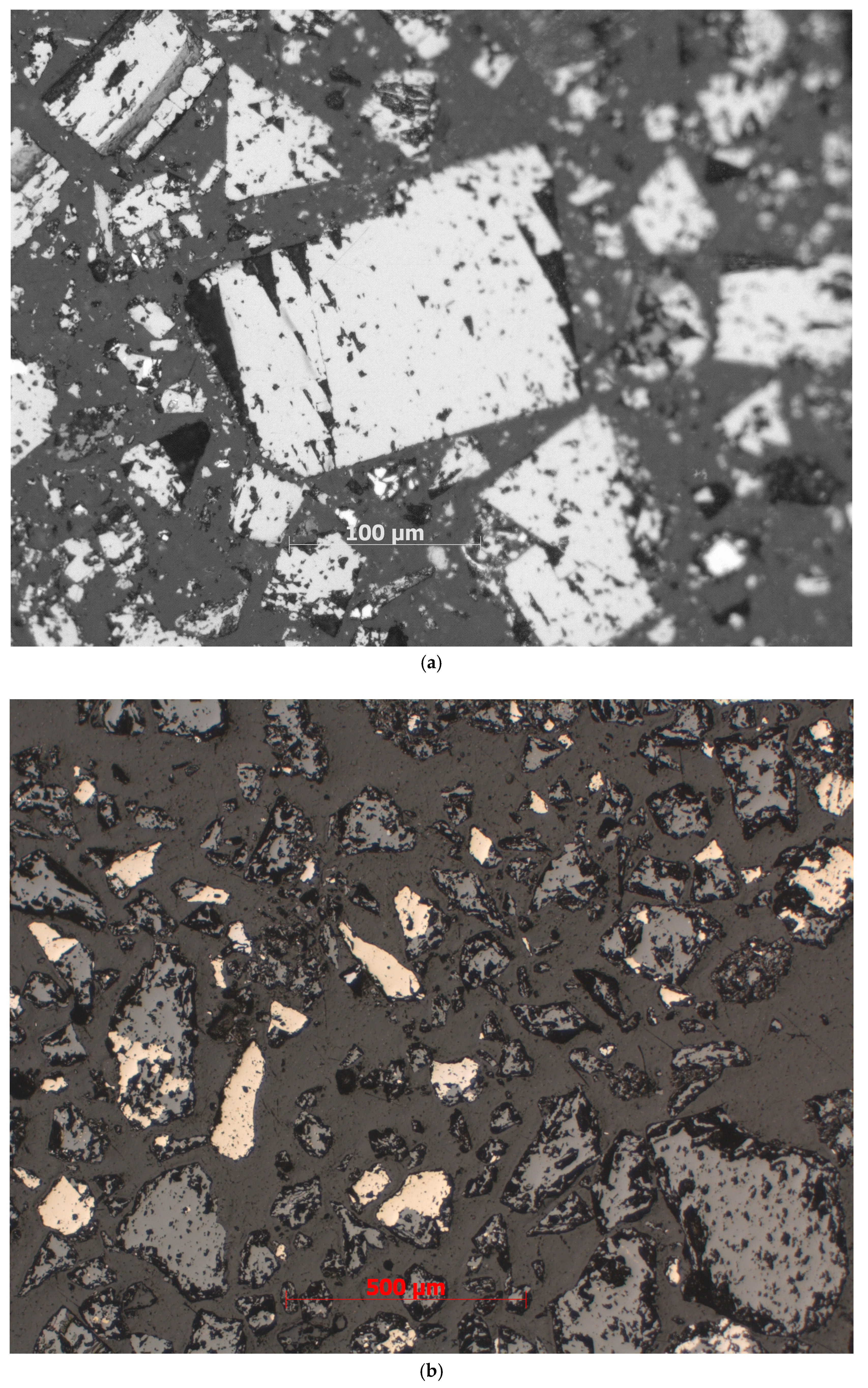
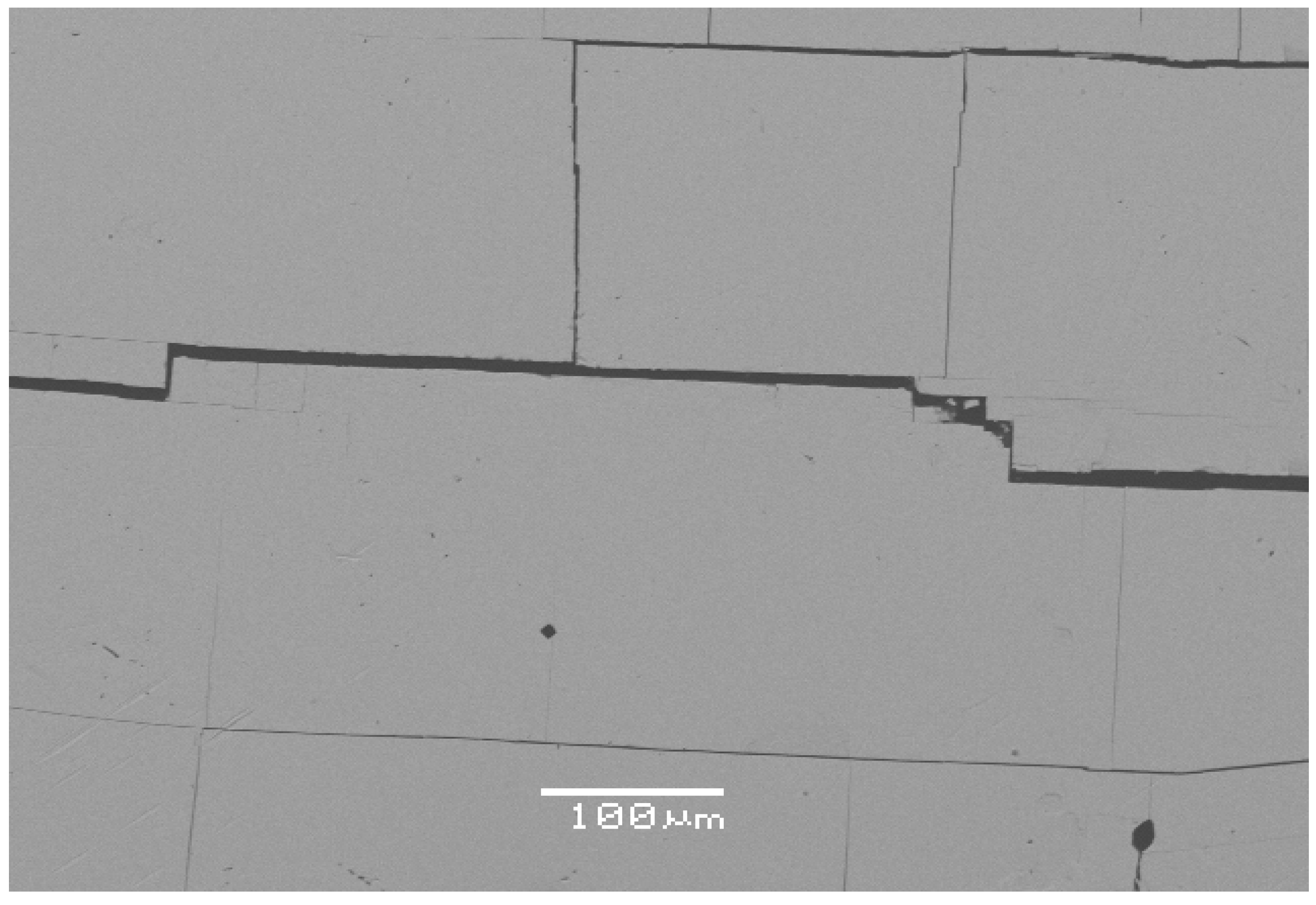
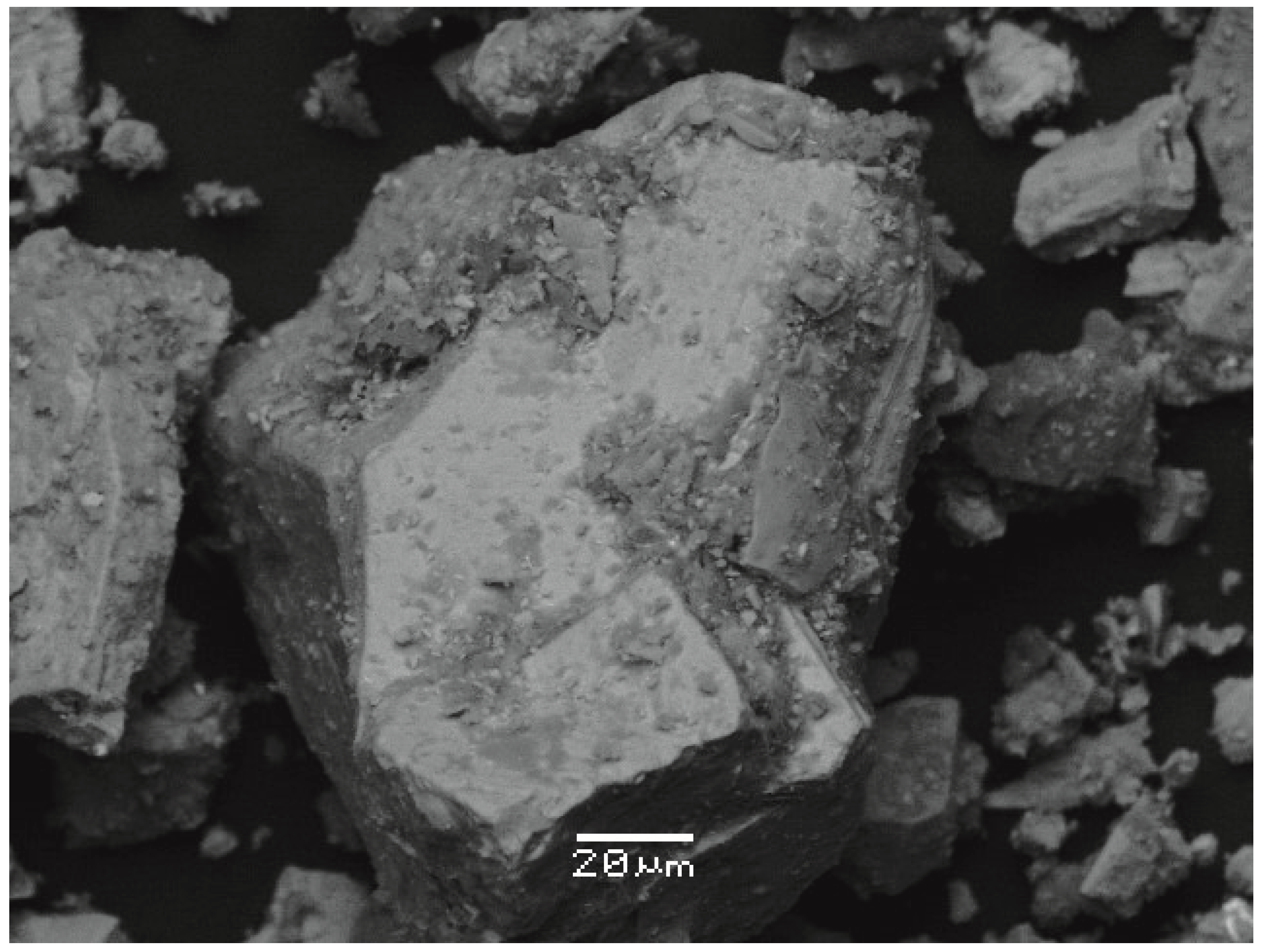
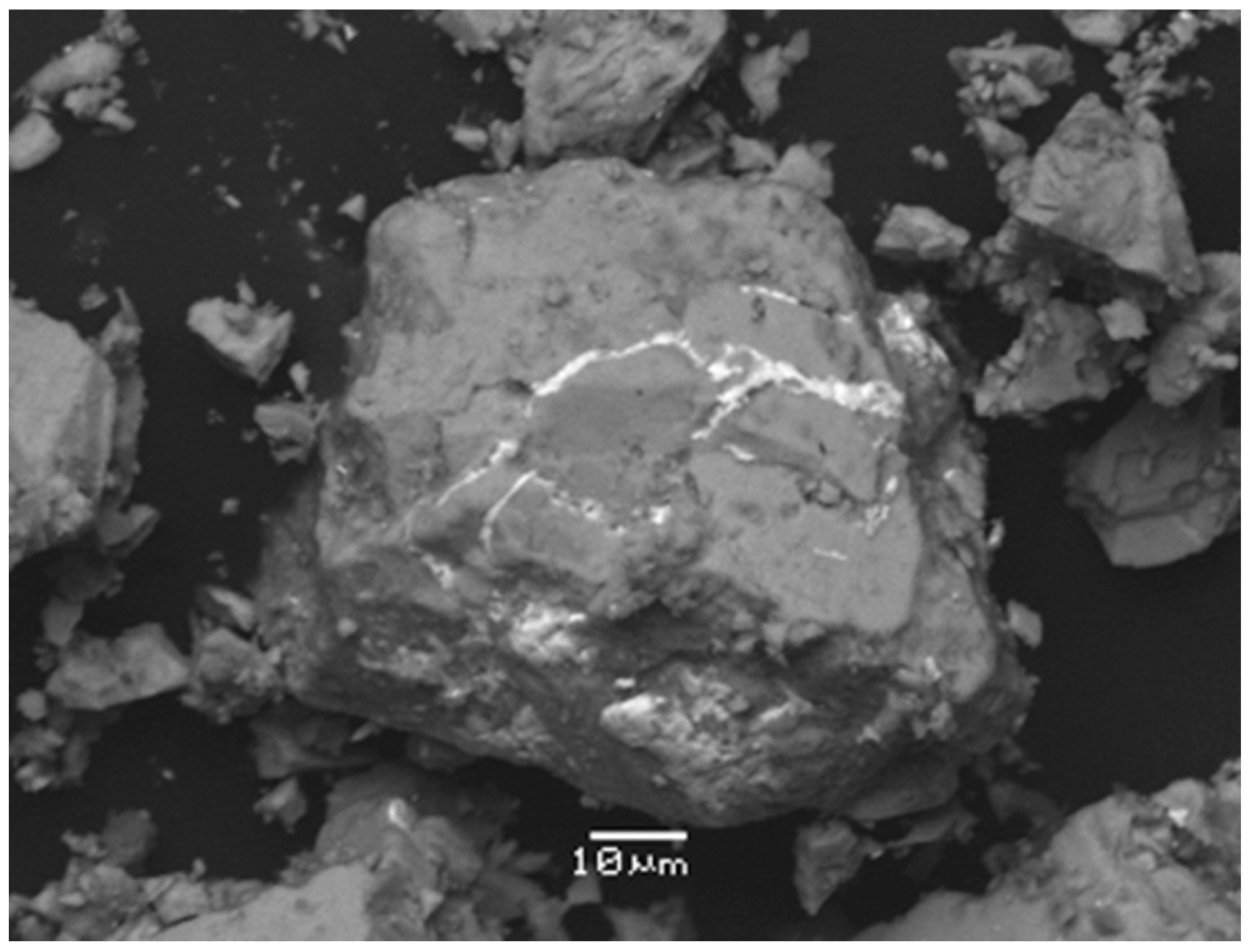
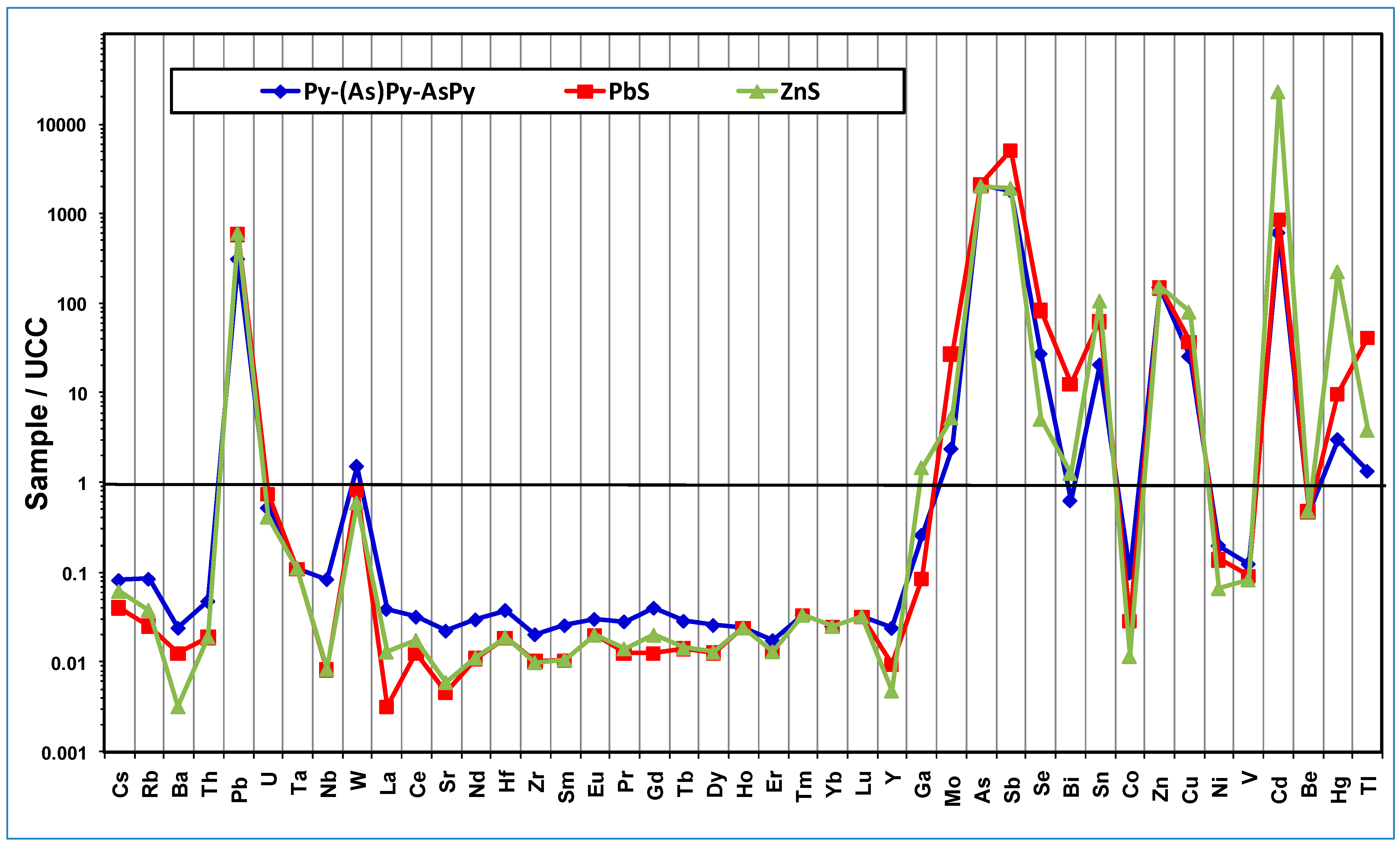
| Phase | Sphalerite | Galena | Arsenopyrite | Pyrite | ||||||||
|---|---|---|---|---|---|---|---|---|---|---|---|---|
| End Member | (Zn,Fe)S | PbS | FeAsS | FeS2 | ||||||||
| Analysis No. | 2 | 3 | 4 | 15 | 16 | 17 | 10 | 11 | 1 | 5 | 6 | 7 |
| As | 0.03 | bdl | bdl | bdl | 0.01 | 0.02 | bdl | 0.01 | 42.08 | 1.08 | 1.40 | 1.24 |
| Fe | 8.35 | 7.05 | 10.07 | 8.37 | 8.22 | 7.48 | 0.46 | 0.08 | 36.07 | 47.54 | 47.56 | 47.12 |
| Mn | 0.58 | 0.61 | 0.38 | 0.43 | 0.57 | 0.49 | bdl | bdl | bdl | 0.06 | bdl | 0.02 |
| Pb | bdl | 0.06 | 0.14 | 0.05 | 0.08 | 0.02 | 85.91 | 84.86 | 0.08 | 0.12 | 0.02 | 0.16 |
| S | 34.37 | 34.33 | 34.59 | 34.52 | 34.42 | 34.53 | 13.33 | 13.38 | 22.37 | 52.76 | 52.58 | 53.12 |
| Zn | 56.84 | 59.13 | 55.58 | 57.04 | 57.71 | 58.24 | 0.79 | 0.28 | 1.33 | 0.07 | 0.53 | 0.28 |
| Total | 100.18 | 101.18 | 100.75 | 100.41 | 101.01 | 100.79 | 100.48 | 98.61 | 101.94 | 101.63 | 102.09 | 101.95 |
| Ions based on: | 1 (S) | 1 (S) | 1 (S) | 2 (S) | ||||||||
| As | --- | --- | --- | --- | --- | --- | --- | --- | 0.81 | 0.02 | 0.02 | 0.02 |
| Fe | 0.14 | 0.12 | 0.17 | 0.14 | 0.14 | 0.12 | 0.02 | --- | 0.93 | 1.03 | 1.04 | 1.02 |
| Mn | 0.01 | 0.01 | 0.01 | 0.01 | 0.01 | 0.01 | --- | --- | --- | --- | --- | --- |
| Pb | --- | --- | --- | --- | --- | --- | 1.00 | 0.98 | --- | --- | --- | --- |
| S | 1.00 | 1.00 | 1.00 | 1.00 | 1.00 | 1.00 | 1.00 | 1.00 | 1.00 | 2.00 | 2.00 | 2.00 |
| Zn | 0.81 | 0.84 | 0.79 | 0.81 | 0.82 | 0.83 | 0.03 | 0.01 | 0.03 | --- | 0.01 | 0.01 |
| Phase | Galena | Arsenopyrite | Pyrite | |||||||||||
|---|---|---|---|---|---|---|---|---|---|---|---|---|---|---|
| End Member | PbS | FeAsS | FeS2 | |||||||||||
| Analysis No. | 1 | 4 | 5 | 6 | 13 | 14 | 2 | 7 | 8 | 9 | 3 | 10 | 11 | 12 |
| As | 0.04 | 0.01 | 0.03 | 0.03 | 0.03 | 0.02 | 41.53 | 42.43 | 41.60 | 43.41 | 1.03 | 0.11 | 2.03 | 1.92 |
| Fe | bdl | bdl | bdl | bdl | bdl | bdl | 36.52 | 36.22 | 36.55 | 36.04 | 47.12 | 47.71 | 47.19 | 47.03 |
| Mn | 0.02 | 0.02 | bdl | 0.04 | 0.03 | 0.01 | 0.01 | 0.02 | 0.04 | bdl | 0.03 | 0.04 | bdl | 0.05 |
| Pb | 86.33 | 85.87 | 85.66 | 85.76 | 85.92 | 86.12 | 0.17 | 0.10 | 0.16 | bdl | 0.16 | 0.14 | 0.15 | 0.21 |
| S | 13.61 | 13.42 | 13.56 | 13.54 | 13.52 | 13.67 | 23.72 | 22.46 | 23.02 | 22.05 | 53.15 | 53.69 | 52.04 | 52.67 |
| Zn | bdl | 0.02 | 0.12 | bdl | 0.08 | bdl | 0.18 | 0.06 | 0.08 | bdl | 0.02 | 0.08 | bdl | 0.05 |
| Total | 100.01 | 99.33 | 99.37 | 99.37 | 99.58 | 99.82 | 102.13 | 101.29 | 101.45 | 101.50 | 101.50 | 101.76 | 101.41 | 101.93 |
| Ions based on: | 1 (S) | 1 (S) | 2 (S) | |||||||||||
| As | --- | --- | --- | --- | --- | --- | 0.75 | 0.81 | 0.77 | 0.84 | 0.02 | --- | 0.03 | 0.03 |
| Fe | --- | --- | --- | --- | --- | --- | 0.88 | 0.93 | 0.91 | 0.94 | 1.02 | 1.02 | 1.04 | 1.03 |
| Mn | --- | --- | --- | --- | --- | --- | --- | --- | --- | --- | --- | --- | --- | --- |
| Pb | 0.98 | 0.99 | 0.98 | 0.98 | 0.98 | 0.98 | --- | --- | --- | --- | --- | --- | --- | --- |
| S | 1.00 | 1.00 | 1.00 | 1.00 | 1.00 | 1.00 | 1.00 | 1.00 | 1.00 | 1.00 | 2.00 | 2.00 | 2.00 | 2.00 |
| Zn | --- | --- | --- | --- | --- | --- | --- | --- | --- | --- | --- | --- | --- | --- |
| Phase | Sphalerite | Boulangerite | Arsenopyrite | Pyrite | ||||||||||||
|---|---|---|---|---|---|---|---|---|---|---|---|---|---|---|---|---|
| End Member | (Zn,Fe)S | Pb5Sb4S11 | FeAsS | FeS2 | ||||||||||||
| Analysis No. | 1 | 13 | 14 | 15 | 2 | 3 | 16 | 17 | 18 | 20 | 5 | 6 | 7 | 19 | 21 | 22 |
| As | bdl | 0.22 | 0.58 | 0.35 | 41.02 | 41.35 | 41.07 | 41.22 | 41.43 | 41.18 | 2.03 | 0.02 | 1.43 | 0.89 | 1.68 | 1.24 |
| Fe | 11.28 | 0.11 | 0.43 | 0.15 | 36.41 | 36.77 | 36.52 | 36.55 | 36.85 | 36.57 | 47.42 | 47.82 | 47.25 | 47.55 | 47.74 | 47.33 |
| Mn | 0.61 | 0.03 | 0.06 | 0.06 | 0.03 | 0.02 | 0.03 | 0.03 | 0.22 | 0.23 | bdl | bdl | bdl | bdl | bdl | bdl |
| Pb | 0.10 | 54.76 | 54.38 | 56.25 | 0.04 | 0.07 | 0.05 | 0.06 | 0.05 | 0.04 | 0.17 | 0.14 | 0.12 | 0.15 | 0.13 | 0.16 |
| S | 34.55 | 17.99 | 17.66 | 18.23 | 23.47 | 22.73 | 22.84 | 23.15 | 22.36 | 22.94 | 52.03 | 53.90 | 52.45 | 53.11 | 52.17 | 52.41 |
| Zn | 53.64 | 0.21 | 0.05 | bdl | 0.10 | 0.16 | 0.13 | 0.15 | 0.17 | 0.15 | bdl | 0.04 | bdl | 0.03 | bdl | 0.02 |
| Sb | n/a | 27.08 | 27.12 | 26.51 | n/a | n/a | n/a | n/a | n/a | n/a | n/a | n/a | n/a | n/a | n/a | n/a |
| Total | 100.17 | 100.40 | 100.27 | 101.55 | 101.07 | 101.10 | 100.64 | 101.16 | 101.08 | 101.10 | 101.65 | 101.92 | 101.25 | 101.74 | 101.72 | 101.16 |
| Ions based on: | 1 (S) | 11 (S) | 1 (S) | 2 (S) | ||||||||||||
| As | --- | 0.06 | 0.15 | 0.09 | 0.75 | 0.78 | 0.77 | 0.76 | 0.79 | 0.77 | 0.03 | --- | 0.02 | 0.01 | 0.03 | 0.02 |
| Fe | 0.19 | 0.04 | 0.15 | 0.05 | 0.89 | 0.93 | 0.92 | 0.91 | 0.95 | 0.92 | 1.05 | 1.02 | 1.03 | 1.03 | 1.05 | 1.04 |
| Mn | 0.01 | 0.01 | 0.02 | 0.02 | --- | --- | --- | --- | 0.01 | 0.01 | --- | --- | --- | --- | --- | --- |
| Pb | --- | 5.18 | 5.24 | 5.25 | --- | --- | --- | --- | --- | --- | --- | --- | --- | --- | --- | --- |
| S | 1.00 | 11.00 | 11.00 | 11.00 | 1.00 | 1.00 | 1.00 | 1.00 | 1.00 | 1.00 | 2.00 | 2.00 | 2.00 | 2.00 | 2.00 | 2.00 |
| Zn | 0.76 | 0.06 | 0.01 | --- | --- | --- | --- | --- | --- | --- | --- | --- | --- | --- | --- | --- |
| Sb | n/a | 4.36 | 4.45 | 4.21 | n/a | n/a | n/a | n/a | n/a | n/a | n/a | n/a | n/a | n/a | n/a | n/a |
| Element | Detection Limit (ppm) | Py-AsPy Conc. OLYMPIAS | PbS Conc. STRATONI | ZnS Conc. STRATONI |
|---|---|---|---|---|
| Pb | 0.1 | 5235.9 | >10,000 | >10,000 |
| Zn | 1 | >10,000 | >10,000 | >10,000 |
| Ag | 0.1 | 22.5 | >100.0 | >100.0 |
| Au | 0.0005 | 16.9 | 1.1 | 1.0 |
| Cu | 0.1 | 710.8 | 1035.9 | 2191.1 |
| As | 0.5 | >10,000 | >10,000 | 9476.9 |
| Sb | 0.1 | 712.9 | >2000.0 | 748.2 |
| Bi | 0.1 | 0.1 | 2.0 | 0.2 |
| Cd | 0.1 | 54.5 | 77.7 | >2000.0 |
| Ni | 0.1 | 9.3 | 6.6 | 3.1 |
| Co | 0.2 | 1.7 | 0.5 | 0.2 |
| Hg | 0.01 | 0.15 | 0.49 | 10.98 |
| Tl | 0.1 | 1.2 | 37.2 | 3.4 |
| Se | 0.5 | 2.7 | 8.3 | <0.5 |
| Be | 1 | <1 | <1 | <1 |
| Th | 0.2 | 0.5 | <0.2 | <0.2 |
| U | 0.1 | 1.4 | 2.0 | 1.1 |
| Sn | 1 | 43 | 131 | 218 |
| Mo | 0.1 | 2.6 | 29.9 | 5.7 |
| Ga | 0.5 | 4.5 | 1.5 | 25.4 |
| V | 8 | 12 | 9 | <8 |
| Nb | 0.1 | 1.0 | <0.1 | <0.1 |
| Ta | 0.1 | <0.1 | <0.1 | <0.1 |
| W | 0.5 | 1.8 | 1.0 | 0.7 |
| Ba | 1 | 15 | 8 | 2 |
| Cs | 0.1 | 0.4 | 0.2 | 0.3 |
| Hf | 0.1 | 0.2 | <0.1 | <0.1 |
| Rb | 0.1 | 6.9 | 2.1 | 3.1 |
| Sr | 0.5 | 7.1 | 1.5 | 1.9 |
| Zr | 0.1 | 3.9 | 2.0 | 1.9 |
| Y | 0.1 | 0.5 | 0.2 | 0.1 |
| La | 0.1 | 1.2 | <0.1 | 0.4 |
| Ce | 0.1 | 2.0 | 0.8 | 1.1 |
| Pr | 0.02 | 0.20 | 0.09 | 0.10 |
| Nd | 0.3 | 0.8 | <0.3 | <0.3 |
| Sm | 0.05 | 0.12 | <0.05 | <0.05 |
| Eu | 0.02 | 0.03 | <0.02 | <0.02 |
| Gd | 0.05 | 0.16 | <0.05 | 0.08 |
| Tb | 0.01 | 0.02 | <0.01 | <0.01 |
| Dy | 0.05 | 0.10 | <0.05 | <0.05 |
| Ho | 0.02 | <0.02 | <0.02 | <0.02 |
| Er | 0.03 | 0.04 | <0.03 | <0.03 |
| Tm | 0.01 | 0.01 | <0.01 | <0.01 |
| Yb | 0.05 | <0.05 | <0.05 | <0.05 |
| Lu | 0.01 | 0.01 | <0.01 | <0.01 |
| 238U-series | 232Th-series | 40K | ||||||||||
|---|---|---|---|---|---|---|---|---|---|---|---|---|
| Sample | 238U | 226Ra | 232Th | 228Th | 226Ra | 232Th | ||||||
| Bq∙kg−1 | ±σ | Bq∙kg−1 | ±σ | Bq∙kg−1 | ±σ | Bq∙kg−1 | ±σ | Bq∙kg−1 | ±σ | ppm | ppm | |
| OLY-C-(FeAsS) | bdl * | - | 24.8 | 0.3 | 4.1 | 0.7 | 3.3 | 0.2 | 51.5 | 2.9 | 2.0 | 1.0 |
| STR-(PbS) | bdl | - | 22.0 | 0.3 | 1.0 | 0.5 | B.D.L. | - | 10.8 | 2.1 | 1.8 | 0.2 |
| STR-(ZnS) | bdl | - | 19.1 | 0.4 | 1.3 | 0.8 | B.D.L. | - | 18.2 | 2.8 | 1.5 | 0.3 |
© 2019 by the authors. Licensee MDPI, Basel, Switzerland. This article is an open access article distributed under the terms and conditions of the Creative Commons Attribution (CC BY) license (http://creativecommons.org/licenses/by/4.0/).
Share and Cite
Tzamos, E.; Papadopoulos, A.; Grieco, G.; Stoulos, S.; Bussolesi, M.; Daftsis, E.; Vagli, E.; Dimitriadis, D.; Godelitsas, A. Investigation of Trace and Critical Elements (Including Actinides) in Flotation Sulphide Concentrates of Kassandra Mines (Chalkidiki, Greece). Geosciences 2019, 9, 164. https://doi.org/10.3390/geosciences9040164
Tzamos E, Papadopoulos A, Grieco G, Stoulos S, Bussolesi M, Daftsis E, Vagli E, Dimitriadis D, Godelitsas A. Investigation of Trace and Critical Elements (Including Actinides) in Flotation Sulphide Concentrates of Kassandra Mines (Chalkidiki, Greece). Geosciences. 2019; 9(4):164. https://doi.org/10.3390/geosciences9040164
Chicago/Turabian StyleTzamos, Evangelos, Argyrios Papadopoulos, Giovanni Grieco, Stylianos Stoulos, Micol Bussolesi, Emmanouil Daftsis, Eleftheria Vagli, Dimitrios Dimitriadis, and Athanasios Godelitsas. 2019. "Investigation of Trace and Critical Elements (Including Actinides) in Flotation Sulphide Concentrates of Kassandra Mines (Chalkidiki, Greece)" Geosciences 9, no. 4: 164. https://doi.org/10.3390/geosciences9040164
APA StyleTzamos, E., Papadopoulos, A., Grieco, G., Stoulos, S., Bussolesi, M., Daftsis, E., Vagli, E., Dimitriadis, D., & Godelitsas, A. (2019). Investigation of Trace and Critical Elements (Including Actinides) in Flotation Sulphide Concentrates of Kassandra Mines (Chalkidiki, Greece). Geosciences, 9(4), 164. https://doi.org/10.3390/geosciences9040164









